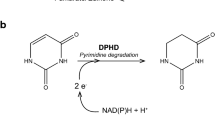Abstract
The gene (CaODC) coding for ornithine decarboxylase, a key enzyme in polyamine biosynthesis, was cloned from Candida albicans by PCR and characterized. The deduced protein contains 470 amino acids together with the substrate- and co-factor-binding sequences which define the ornithine decarboxylases of eukaryotic species. It shows a high homology with other ODCs, mainly those from Saccharomyces cerevisiae and Neurospora crassa. A putative PEST sequence, which correlates quite well with those described for other fungal ODCs, could be identified in the protein. The mRNA of the gene is 2.4 kb in size and by primer extension a long leader sequence was found at –558 bases upstream of the predicted start of translation. An identical single ODC gene was identified in three different C. albicans strains. During the dimorphic switch, a transient initial increase in ODC activity was observed. This increase was not accompanied by a rise in the levels of the transcript, suggesting that ODC activity levels may be regulated post-transcriptionally during differentiation.
Similar content being viewed by others
Author information
Authors and Affiliations
Additional information
Received: 17 February / 15 May 1997
Rights and permissions
About this article
Cite this article
López, M., García, S., Ruiz-Herrera, J. et al. The ornithine decarboxylase gene from Candida albicans. Sequence analysis and expression during dimorphism. Curr Genet 32, 108–114 (1997). https://doi.org/10.1007/s002940050254
Issue Date:
DOI: https://doi.org/10.1007/s002940050254




